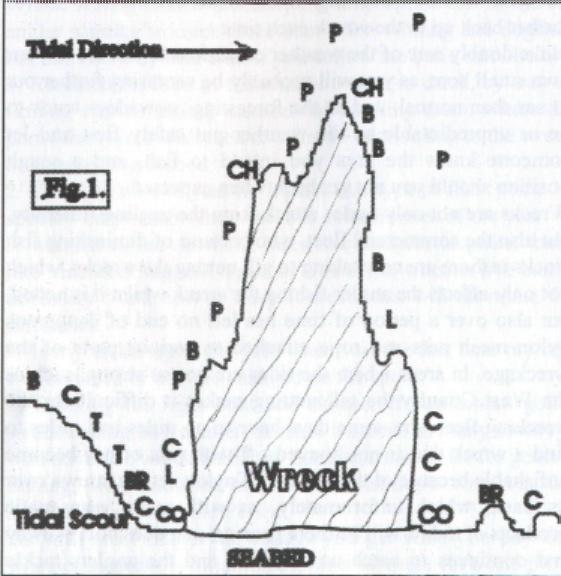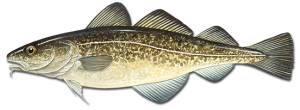 |
 |
 |
 |
 |
 |
 |
 |
 |
 |
 |
 |
 |
 |
 |
 |
 |
 |
 |
 |
 |
 |
 |
 |
 |
 |
 |
 |
 |
 |
 |
 |
 |
 |
 |
 |
 |
 |
 |
|
|
 |
|
|
|
 |
|
 |
|
|
|
Cod |
|
|
|
|
|
|
|
 |
|
|
|
|
|
|
|
Common on most coasts of Ireland where the colour of this fish can vary between greenish grey to red-brown, depending on the area inhabited. The Cod has a good tolerance for brackish water and is known to exist in many of the larger estuaries. Particularly the east and south coasts. Particular hot spots are Wicklow, Ballycotton Cork and just north of Arklow. Kilmore key and other parts of wexford also sees its fair share of good Cod each year. |
|
|
|
|
Distribution: |
|
|
|
|
|
|
|
|
|
|
|
|
Habitat: |
|
The Cod is happy living over most sea beds. As with all fish the most important factor is food. Clean sand, mud, rough ground, shingle, reefs and of course wrecks. It is true however that the bigger fish tend to prefer rougher ground where there is more food and it is wrecks that account for the truly huge fish. |
|
|
|
|
|
|
|
|
|
|
|
Young codling up to 4lb feed predominently on shrimp, Brittle star fish, worms, crab, shellfish and fry. The larger fish change their diet to mainly to fish. Small fish like Pouting, Whiting, Dabs, Sprats and Poor Cod are usual targets. Generally the slower swimmers!
Cod will go on killing sprees for a particular bait when that bait is in abundance and for that reason some baits work better in some areas than others. In the south of the country Crab seems to be best for the smaller fish with the great wreck fish falling to squid and cuttlefish. In the east of the country worm baits work great tipped with squid. |
|
|
|
|
Baits: |
|
|
|
|
|
|
|
|
|
|
|
|
Tide and sea conditions: |
|
|
|
|
|
The big tides of the month generally produce the better fish. Shoals of Cod move in to pick up the food in the strong currents and fishing over channels and holes at these times can produce fish. Neap tides tend to be better for the wreck fish as the slower water can allow a slower drift over the wreck giving you more time on the fish and thus more time actually fishing. As always just after a blow is a good time to fish for Cod as the sea can still be very dirty from a storm. This will give the fish more courage and they will be cruising the tidal runs searching for food items killed and dislodged in the storm. In strong tides you should try making your hook lengths longer. These can be up to 8' depending on the strength of the tide. |
|
|
|
|
|
|
|
|
|
|
|
Cod love broken ground and kelp beds. These features standing alone on a sandy bottom will almost surely hold Cod. Cod use these features for protection and camoflage and will lurk in front and behind them waiting in ambush away from the main tide run. As the food stuffs race past the feature caught up in the tidal race often they will make for the feature for protection where the Cod are waiting for them... This is why wrecks make such good Cod holding spots. It is in and around the wreck on the botom where the cod will be found as shown in the picture below. The Cod are the 'C' marked on the picture. Big Cod tend to take Pirks between 10oz and 2lb and ledgered Redgills, Shads and Muppets worked near the bottom. Another tip many anglers use is to mount a Muppet on the Pirk hook below the Pirk. Over cleaner sand areas it can be enough to allow your feather rigs to just drag the sinker along the bottom. On mixed ground the slightest nods of the feather rig can be enough to induce a strike. Allow your lead to hit the bottom from time to time. This will create little puffs of sand which will attract the cods attention |
|
|
|
|
Tactics: |
|
|
|
|
|
|
|
|
|
|
|
|
 |
|
|
|
|
|
|
|
 |
|
|
|
|
|
|
|
Cod Profile |
|
|
|
|
|
|
|
Back to Species List |
|
|
|
|
Back to Home Page |
|
|
|
|
|
|
|
|
|
|
|
|
 |
|
|
|
|

